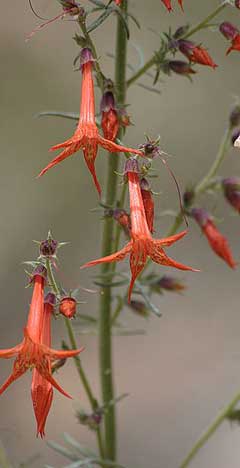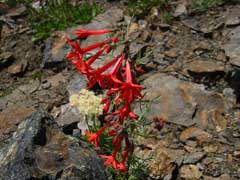 |
|
http://commons.wikimedia.org/wiki/User:JerryFriedman |
 |
| http://commons.wikimedia.org/wiki/User:Wsiegmund |
Translate this page:
Summary
Physical Characteristics

 Ipomopsis aggregata is a BIENNIAL/PERENNIAL growing to 1 m (3ft 3in) by 0.3 m (1ft) at a slow rate.
Ipomopsis aggregata is a BIENNIAL/PERENNIAL growing to 1 m (3ft 3in) by 0.3 m (1ft) at a slow rate.
See above for USDA hardiness. It is hardy to UK zone 7. It is in flower from June to July. The species is hermaphrodite (has both male and female organs).
Suitable for: light (sandy) and medium (loamy) soils and prefers well-drained soil. Suitable pH: mildly acid, neutral and basic (mildly alkaline) soils. It cannot grow in the shade. It prefers dry or moist soil.
UK Hardiness Map
US Hardiness Map
Synonyms
Gilia aggregata. (Pursh.)Spreng.
Plant Habitats
Cultivated Beds;
Edible Uses
Edible Parts: Nectar
Edible Uses: Tea
The plant has been boiled up as a tea[257]. The nectar is sucked from the flowers by children[257].
References More on Edible Uses
Medicinal Uses
Plants For A Future can not take any responsibility for any adverse effects from the use of plants. Always seek advice from a professional before using a plant medicinally.
Cathartic Disinfectant Emetic Skin Tonic
The whole plant is cathartic and emetic[61, 257]. The leaves are steeped in hot water until the water turns a bright green, this liquid is taken in small doses as a tonic for the blood[207, 257]. An infusion of the whole plant has been used to treat blood diseases[257]. A decoction has been used as a disinfectant wash on itchy skin[257]. A poultice of the whole plant has been applied to rheumatic joints[257]. An infusion of the roots is used as a laxative and in the treatment of high fevers, colds[257].
References More on Medicinal Uses
The Bookshop: Edible Plant Books
Our Latest books on Perennial Plants For Food Forests and Permaculture Gardens in paperback or digital formats.

Edible Tropical Plants
Food Forest Plants for Hotter Conditions: 250+ Plants For Tropical Food Forests & Permaculture Gardens.
More

Edible Temperate Plants
Plants for Your Food Forest: 500 Plants for Temperate Food Forests & Permaculture Gardens.
More

More Books
PFAF have eight books available in paperback and digital formats. Browse the shop for more information.
Shop Now
Other Uses
Adhesive Disinfectant Soap
The plant is reported to contain saponins[212] and so could possibly be used as a soap substitute[K]. A decoction of the plant has been used as a face and hair wash by adolescent girls[257]. The whole plant has been boiled up to make a glue[257].
Special Uses
Scented Plants
References More on Other Uses
Cultivation details
Requires a well-drained dry soil in sun or partial shade[187]. Requires a light very well drained fertile soil in full sun[200]. Plants are cold-hardy to about -15°c[187], but they are susceptible to rot in areas with wet winters[260]. It is best to cover the plants with a pane of glass in wet winter areas[260]. A slow-growing[188] and short-lived perennial or biennial species[187]. A polymorphic species[60]. The leaves have a musky scent[187]. The crushed leaves smell like a skunk[212].
References Carbon Farming Information and Carbon Sequestration Information
Temperature Converter
Type a value in the Celsius field to convert the value to Fahrenheit:
Fahrenheit:
The PFAF Bookshop
Plants For A Future have a number of books available in paperback and digital form. Book titles include Edible Plants, Edible Perennials, Edible Trees,Edible Shrubs, Woodland Gardening, and Temperate Food Forest Plants. Our new book is Food Forest Plants For Hotter Conditions (Tropical and Sub-Tropical).
Shop Now
Plant Propagation
Seed - sow spring in situ[200].
Other Names
If available other names are mentioned here
Native Range
NORTHERN AMERICA: Canada (British Columbia (south)), United States (Colorado, Idaho, Montana, Oregon, Washington, Wyoming, New Mexico, Texas, Arizona, California, Nevada, Utah), Mexico (Chihuahua, Coahuila de Zaragoza, Nuevo León, Tamaulipas)
Weed Potential
Right plant wrong place. We are currently updating this section.
Please note that a plant may be invasive in one area but may not in your area so it's worth checking.
Conservation Status
IUCN Red List of Threatened Plants Status :

Growth: S = slow M = medium F = fast. Soil: L = light (sandy) M = medium H = heavy (clay). pH: A = acid N = neutral B = basic (alkaline). Shade: F = full shade S = semi-shade N = no shade. Moisture: D = dry M = Moist We = wet Wa = water.
Now available:
Food Forest Plants for Mediterranean Conditions
350+ Perennial Plants For Mediterranean and Drier Food Forests and Permaculture Gardens.
[Paperback and eBook]
This is the third in Plants For A Future's series of plant guides for food forests tailored to
specific climate zones. Following volumes on temperate and tropical ecosystems, this book focuses
on species suited to Mediterranean conditions—regions with hot, dry summers and cool, wet winters,
often facing the added challenge of climate change.
Read More
Expert comment
Author
(Pursh.)V.E.Grant.
Botanical References
200204
Links / References
For a list of references used on this page please go here
Readers comment
| Add a comment |
|
If you have important information about this plant that may help other users please add a comment or link below. Only comments or links that are felt to be directly relevant to a plant will be included. If you think a comment/link or information contained on this page is inaccurate or misleading we would welcome your feedback at [email protected]. If you have questions about a plant please use the Forum on this website as we do not have the resources to answer questions ourselves.
* Please note: the comments by website users are not necessarily those held by PFAF and may give misleading or inaccurate information.
To leave a comment please Register or login here All comments need to be approved so will not appear immediately.
|
Subject : Ipomopsis aggregata
|
|
|
|